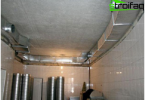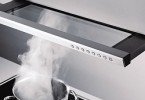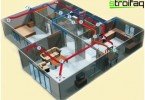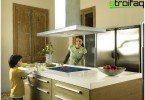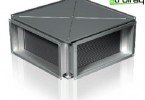“Necessary, like air” – we are talking about something crucial, wanting to emphasize the special status as the obvious value of the vital. To say something, we say that it is only for everyday concerns that the importance of getting fresh air somehow imperceptibly recedes into the background. The desire to improve the interior of his house finds a way out in the installation of brand new sealed double-glazed windows. The desire for rational spending of funds drives us when among the variety of options for entrance doors we choose the ones that are least susceptible to temperature and humidity changes and are tightly adjacent to the box steel. We also usually do not rush to open a window for airing in the cold season, trying to keep valuable heat. At first glance, there is nothing reprehensible or unusual in the above. Here are just the most common ventilation in the apartment works only if free air flows from all residential premises, with a mandatory influx of fresh air. Today we will examine in detail the peculiarity of the ventilation device of a modern apartment, we will learn how to achieve compliance with air exchange standards, in order to find the answer to the main question about whether effective ventilation in the apartment can be arranged with your own hands.
Content
- Getting to know how normal ventilation works
- Determine air exchange rates
- The principle of natural air circulation
- Forced ventilation device
- Forced-air exchange method
- Supply and exhaust ventilation – advantages
It is not possible to consider the above-described average apartment as a single volume of air (each room has its own degree of pollution, tightly closed windows and doors impede air exchange). The result is an extremely unhealthy atmosphere, with this state of affairs, the supply and exhaust ventilation for the apartment (most often used in urban high-rise buildings) is ineffective, if not dangerous. Excessive heat, and even in combination with increased humidity and low air mobility favor the growth of pathogenic fungi and mold. Consider today how the ventilation system in an apartment should be organized.
Getting to know how normal ventilation works
Residents of urban high-rise buildings before did not even think about how to make ventilation in the apartment. Naturally, the understanding that continuous air exchange should take place in any room (fresh air intake and removal of polluted air) was present, but we all had enough understanding that ventilation in the apartment in the kitchen and in the bathroom was well thought out: exhaust ducts are removed through exhaust ducts. Admission is made by seeping outside air through an open window or leaking windows and doors. Indeed, at that time the system of natural ventilation was fully justified. Today, with the insufficient effectiveness of this method (we mentioned the reasons above), the installation of additional devices is required. Forced ventilation in the apartment will be effective only if the equipment is correctly selected (the choice is made on the basis of air exchange calculations).
Determine air exchange rates
It is not difficult to determine the necessary amount of supply air: it is enough to compare the known ventilation standards in the apartment with the area of the room and the number of residents. So for each square meter of area air exchange of 3 m3 / hour is required, and for each adult 30 m3 / hour. Based on these standards, it is not difficult to calculate the air exchange for each specific case and develop a project for ventilation of the apartment, choosing the most profitable method and the required equipment.
The ventilation device in the apartment can be carried out using traction arising from the temperature difference between indoor and outdoor air (this method is called natural ventilation) or using traction carried out mechanically. Forced ventilation can be supply, exhaust and supply and exhaust.
The principle of natural air circulation
The easiest way to ventilate the room, in which the air is removed by natural draft through the ventilation ducts, and the inflow through open air vents, leaks in the windows or special air intake devices is called the “natural ventilation system”, which was previously very common, often ineffective today due to the lack of much needed leaks. However, the air flow can be carried out using the supply devices, which are built into walls or windows. An example of such a device is a supply adjustable valve mounted on a sash.
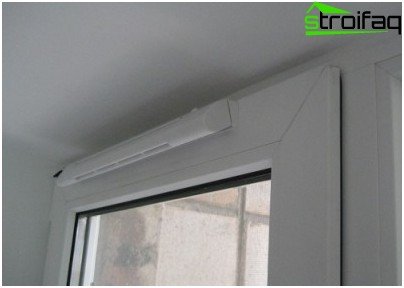
Installing a supply valve does not reduce the soundproofing qualities and does not spoil the appearance of the window
Thanks to the sound-reflecting visor, the device practically does not reduce the sound-proofing qualities of the windows. Installation of the valve takes no more than 15 minutes. Similar in principle, devices can be installed in the walls near the radiators. To do this, you need to make a hole in the wall with a diameter of 50 to 100 mm (depending on the valve model). The undoubted advantage of such models is the simplicity of the device and further maintenance. The efficiency of the supply valves directly depends on the health of the exhaust ventilation ducts. Natural ventilation is most effective in the winter, when the temperature difference is large, providing natural traction. In summer, at a temperature difference of less than 15 ° C, this draft is hardly noticeable..
Forced ventilation device
The forced exhaust ventilation device provides for the removal of exhaust air mechanically. For this, fans are used that are built into the ventilation shaft in the bathroom and electric kitchen hoods. When the fans are working in the apartment, an underpressure is created, causing it to be sucked in from the outside through the supply valves or open windows. In the cold season, it is desirable to provide for the supply air heating, for this purpose it is possible to install the supply devices with built-in electric heaters. When using such devices without heating, they must be placed above the heating devices.
Forced-air exchange method
The main feature of the functioning of the supply ventilation is the forced supply of outdoor air (through the installed supply devices) and the removal of contaminated natural draft through the ventilation shafts in the bathroom and kitchen. Air-handling units come in different models and configurations, but the schematic diagram of the device, as a rule, is the same for everyone (fan, air filter, shut-off valve, heater, noise reflector).
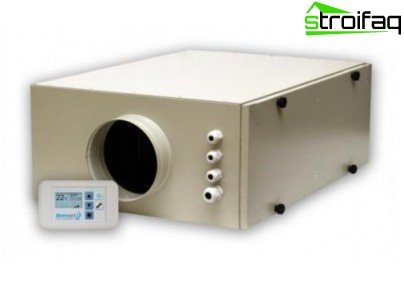
Heated fresh air in winter prevents condensation and mildew formation in the supply
In this case, the installation of ventilation in the apartment requires the installation of a hole in the main wall (the diameter depends on the model of the device) and the connection of the power supply to the supply unit. Such an installation is almost silent in operation, it makes it possible to provide the room with clean, heated air, regardless of the season and weather conditions. To facilitate the functioning of the system in the interior doors there should be a bottom cut of 1.5-2 cm or integrated grilles.
Supply and exhaust ventilation – advantages
With such a system, the entire process of ventilation of the apartment is fully mechanized: the influx and removal of air are forced. Mechanical supply and exhaust ventilation in an apartment is the most convenient and modern way. Indeed, in addition to the ability to heat and clean the supply air stream, it is also possible to use devices with heat recovery, which will reduce heat loss by 70-80%. It is possible to install such equipment in suspended ceilings or utility rooms.
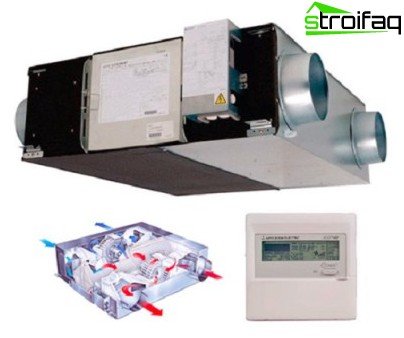
The supply and exhaust device with a recuperator allows you to return to the room the thermal energy of the removed air
The use of supply and exhaust devices with recovery in the summer will significantly reduce the load on the air conditioner, and in winter it will allow you to keep the house warm during ventilation. Thus, heating, ventilation and air conditioning of the apartment, selected taking into account the characteristics of each system, work harmoniously, providing comfortable conditions at low energy costs. Installation of ventilation in the apartment may well be done with your own hands, it will take only some diligence in a detailed study of the issue.


